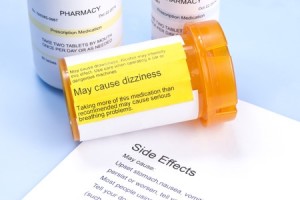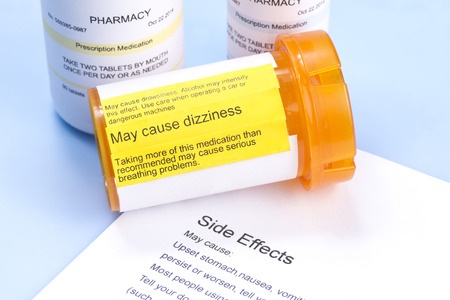
Okay, you probably don’t wonder about things like how many people to visit the emergency department (ED) of a hospital when they experience serious side effects or have an adverse drug reaction (ADE) from psychiatric medications. But when 26.8 million US adults, approximately 11.5% of the adult population, are using psychiatric medications, it’s a good thing that some people do wonder—and then set out to find an answer to their question. A study published in 2014 estimated that there were over 89,000 ED visits due to ADEs from the use of psychiatric medications from 2009 through 2011. That accounted for 9.6% of all adult ADE ED visits during the same time period. Almost half (49.4%) of the visits involved adult patients aged 19 to 44 years old; 33.3% were between 45 and 64; 17.3% of the ED visits were with adults 65 and older.
Hampton et al. used nationally representative public health data to estimate the numbers and rates of ED visits and hospitalizations for ADEs from psychiatric medications among adults between January 1, 2009 and December 31, 2011. To estimate the use of specific medications, they used publically available data from the National Ambulatory Medical Care Survey. To determine the number of US adults, men and women, between 2009 and 2011, they used National Center for Health statistics estimates, which are based on US census data. They excluded all ED visits resulting from intentional self-harm, documents drug abuse, therapeutic failures, nonadherence or drug withdrawal. They looked at the following classes of drugs: antidepressants, antipsychotics, lithium salts, anxiolytics (anti-anxiety drugs) and stimulants.
The researchers found that 52.8% of the adverse events were negative reactions to the drug. Unintentional therapeutic overdoses accounted for 33.8% of the adverse events and 12.9% were due to allergic reactions. Most of the cases were treated and released or left against medical advice (80.7%). But 19.3% were admitted, observed or transferred to another facility. Around 73 percent of the ADEs involved one implicated medication.
But the percentage of individuals seeking treatment for ADEs who were using multiple concurrent medications was high. Only 34.4% were only using one medication. 34.5% were using 1 to 3 medications. 17.7% were using 4 to 5 medications and 13.4% were using six or more concurrent medications. Polypharmacy of four or more concurrent medications involved 31.1% of the ED visits.
Ten specific medications, either alone or in combination with other medications were involved in 57.5% of the adverse drug—related ED visits. The brand names of the medication are in parenthesis. Surprisingly, Ambien or its generic version, was the number one medication implicated in adverse drug—related ED visits. Among adults 65 and over, Ambien alone was responsible for 21% of ED visits. See the table below.
Data from the Drug Abuse Warning Network have shown that ED visits for zolpidem ADEs increased 220% from 2005 to 2010, and previous studies have indicated that zolpidem use is associated with a substantial risk of falls. While the FDA’s recent efforts to modify recommended dosing regimens hold promise for reducing zolpidem ADEs, clinicians can also reduce zolpidem ADEs by prescribing zolpidem for insomnia, its sole FDA-approved indication, only after considering other treatments such as sleep hygiene education, stimulus control, sleep restriction, relaxation training, and cognitive behavior therapy.
|
Medications |
No of Cases |
Estimated # of visits |
% of visits |
|
Zolpidem (Ambien) |
445 |
10,212 |
11.5 |
|
Quetiapine (Seroquel) |
320 |
6900 |
7.7 |
|
Alprazolam (Xanax) |
241 |
5616 |
6.3 |
|
Lorazepam (Ativan) |
233 |
5517 |
6.2 |
|
Haloperidol (Haldol) |
250 |
4879 |
5.5 |
|
Clonazepam (Klonopin) |
215 |
4571 |
5.1 |
|
Trazodone (Oleptro) |
182 |
4249 |
4.8 |
|
Citalopram (Celexa) |
175 |
4143 |
4.6 |
|
Lithium |
217 |
4034 |
4.5 |
|
Risperidone (Risperdal) |
166 |
3662 |
4.1 |
Antipsychotic medications, such as Seroquel, and lithium salts were implicated in significantly more ED visits relative to the number of outpatient visits at which they were prescribed than other psychiatric medications.” Since over 60% of antipsychotic prescribing has been found to be for off-label uses, it is probable that many of these ED visits were from off-label use. Disturbingly, “well over half of the off-label use of antipsychotics may be based on inadequate evidence.
Concerns about antipsychotics’ risks and their possible overuse have prompted the leaders of the American Psychiatric Association to urge providers to prescribe antipsychotics cautiously and only after exploring the feasibility of using alternate treatments.Avoiding antipsychotics in favor of other options less likely to cause ADEs could be particularly appropriate when considering treatment of major depressive disorder, insomnia, or anxiety disorders because the FDA has not approved the use of any antipsychotic for the first-line treatment of major depressive disorder, the use of any antipsychotic for the treatment of insomnia, or the use of any atypical antipsychotic for the treatment of anxiety disorders.
So adverse drug events with psychiatric medications contribute to a significant amount of the ED traffic in US hospitals. And the majority of them were from the misuse of ten specific medications. But it also seems that these adverse events are under reported—perhaps intentionally.
The FDA has an Adverse Event Reporting System (FAERS) that is the government’s primary safety surveillance system for harm resulting from therapeutic drugs. The Institute for Safe Medicine Practices published a Quarter Watch Report that concluded FAERS suffered from “a flood of low quality reports from drug manufacturers and it has not yet been updated for the changing environment in which drugs are marketed to health professionals and consumers.”
The FAERS system is critically important for two reasons. First, a majority of new FDA safety warnings on FDA approved drugs are generated from these ADE reports. “Despite its limitations, FAERS is the most reliable system for discovering new drug risks that had not been identified in pre-market drug testing.” Second, no other system has comparable international scope. It is sensitive enough to detect rare but catastrophic adverse side effects and the capacity to identify unexpected potential injuries.
The total number of adverse events reported to the FDA over a calendar year ending at the first quarter of 2014 (847,039) was more than double that of 2009 (336,753). Additionally, 96.6% of the case reports were collected and written by drug manufacturers. “Thus, the performance of the drug manufacturers, combined with FDA regulations and compliance activity, determines the quality, coverage and completeness of this safety surveillance system.” While the increased numbers of submitted reports indicate the drug manufacturers are now reporting radically more ADEs than in the past, the overall completeness of the reports was poor.
While drug manufacturers are now reporting adverse drug events in unprecedented numbers from around the world, we judged that the overall completeness of adverse event report was poor. For example, in 36% of cases the age of the patient was not determined; in 44% of cases no event date was indicated. A report was classified as reasonably complete if it contained age, gender, and an event date. While 85% of serious reports sent directly to the FDA were reasonably complete, only 49.4% of the manufacturer serious reports met this basic standard. We also identified thousands of case reports where the adverse event was classified as non-serious and indicated only common health problem such as a cold (n = 1,889), the sniffles (n = 906), or an injection that had been painful (n = 4,331). Manufacturer report quality for serious adverse events varied widely. The weakest performance was seen in four companies that submitted reasonably complete reports in only 15% or fewer cases; not one manufacturer equaled the FDA’s 85% record for complete reports; and only 5/74 (7%) manufacturers reported at least age and gender in 90% or more serious reports.
Some of the problems in the reporting system are that it does a poor job with ADEs from older generic drugs and for events involving newborns and children. For birth defects, the reporting is even more limited. Given the drastic increase in the use of psychiatric medications with children over the past twenty years, this seems to be a serious and dangerous flaw. “Even though 86% of outpatient prescriptions are for generic drugs, according to IMS Health Inc., the major brand name manufacturers provide the overwhelming majority of adverse event reports, even when sales of the brand name drug are extremely small.” And despite major global changes with medications and technology in the past fifteen years, the legally binding FDA guidance document specifying how drug manufacturers are to collect and report ADEs since 2001.
The Institute for Safe Medicine Practices concluded that improving FAERS should be a top priority of the FDA. Modernizing the ADE reporting requirements would provide a low-cost opportunity to improve safety surveillance as well as reduce some of the burden on drug manufacturers and focus resources in a more productive direction. Some changes are straightforward: “We can’t think of a good reason why the quality and completeness of serious adverse event reports collected by drug manufacturers is so much worse than those collected online at the FDA.” The failure to get basic information like the patient’s age in 36% of the cases of adverse events suggests poor quality control and weak collection systems. “And does the system really need thousands of non-serious reports of the sniffles or that an injection was painful?”
Other changes may require substantial discussion and debate. Developing clear and usable protocols for manufacturer-initiated contacts with patients or health professionals may require new report data elements, and specific lists of questions to ask. Improving the quality of patient death reports is non-trivial because patient deaths typically involve multiple contributing factors, and assigning cause may be a subjective medical judgment. But there is no point in manufacturers submitting thousands of reports of deaths in which a possible drug role was never alleged, ascertained, or investigated. In all of these situations, much could be gained from requiring a simple critical question in company-initiated contacts that asked: “Was the drug suspected of contributing to the event?”
But can these simple and reasonable changes ever make it past the vast lobbying efforts of the pharmaceutical industry? Links to other reporting on this FDA study can be found here on Mad in America: “FDA System for Recording Adverse Drug Effects Perilously Deficient.”





